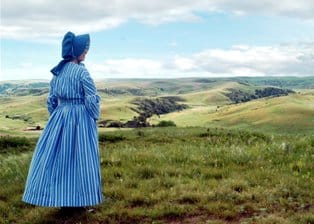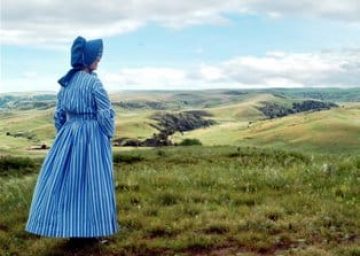 by Emma
by Emma
Emma is not a member of Ordain Women but has been an interested observer over the last several months. This is part of a longer paper Emma wrote addressing several arguments she has heard against women’s ordination.
1. There is no precedence for ordaining women.
Ours is a very male-dominated faith: our scriptures tell the stories of predominantly male prophets, we pray to a Father in Heaven, our General Authorities are exclusively men. In such a visibly male institution it is difficult (but not impossible) to find examples of female authority.
I’d heard before—mostly in quiet voices and vague descriptions—about women laying hands on and blessing one another in the early church, but it was not a phenomenon I had much investigated until recently. As I studied, I was surprised to learn the extent of women’s authority to bless and heal in the early church.
In 1842, at the fifth meeting of the Relief Society, Emma Smith and her counselors “with Joseph’s approval…laid hands on sick sisters and blessed them that they might be healed.”[4]
Relief Society records from the 1840s to the early 1900s document women routinely healing one another. Brigham Young encouraged women healers during the initial days of Relief Society, counseling women, “Why do you not live so as to rebuke disease? It is your privilege to do so without sending for the Elders…It is the privilege of a mother to have faith and to administer to her child; this she can do herself, as well as sending for the Elders to have the benefit of their faith.” [5] At times, women even acted as healers in the temple.[6]
We find something of a scriptural precedent for women’s priesthood when, in 1853, Patriarch John Smith (uncle to Joseph) sealed upon Caroline Cottam “the blessings and Priesthood which Abraham sealed upon his daughters, with power to heal the sick in your house.” In a patriarchal blessing to Elizabeth Bean, he further said that her priesthood gave her “the power to heal the sick and to understand all the principles of the priesthood, and mysteries that have been kept hid from before the foundation of the world.” [7]
From these stories we see the extent of the authority women had in the early days of the church. Understanding the precedent for ordaining women to this type of power, we can reframe Ordain Women not as a radical movement, but in language more familiar to any member of the Church—as something akin to restoration.
2. Women don’t need the Priesthood because men and women are not the same.
This is a line being thrown around a lot in blogosphere lately (even the infamous Frozen[8] blogger has something to say about OW[9]), and while I think it’s a fair point—men and women aren’t exactly the same—I believe it is incorrect to use this reasoning to argue against ordaining women.
I think particularly of statements like the one in recent Deseret News article[10] by Linda and Rich Eyre: “The Eyres reject the notion that equality means sameness when it comes to members of the LDS Church and the priesthood.” Good news, Eyres—I think the majority of church members, supportive of ordination of women to the priesthood or not, can get behind this statement. It surprises and saddens me to see our sisters in OW discredited by accusations that “They just want to be men.” If anything, OW is a movement particularly sensitive to the unique differences between women and men. It is a forum that recognizes women striving to not to take over men’s vocations, but to magnify their own callings as female leaders, caretakers, and disciples of Jesus Christ.
The Eyres affirm “true equality comes only when we realize that two very different things can be precisely equal in importance, in beauty and in ultimate potential,” as if it were an argument against giving women access to priesthood authority; I for one see it as an argument for that very cause. What better way to recognize women as precisely “equal in importance and ultimate potential” than to recognize their importance and potential as ordained enactors of priesthood power?
Furthermore, studying the unique role women played in the early church as members ordained to heal and bless, it seems me that there can absolutely be a difference between male priesthood (as we see it in the church now) and general female authority (as we have seen it in the church in the past). The balance between male and female responsibilities as outlined by the Eyres doesn’t have to be upset by ordaining women; in fact, it can be enhanced, as women take on roles of equal weight and authority to their male partners. There is room for both priests and priestesses in this Church.
[4] Linda King Newell. “A Gift Given, A Gift Taken: Washing, Anointing, and Blessing the Sick Among Mormon Women. http://signaturebookslibrary.org/?p=773
[5] Linda Newell, “The Historical Relationship of Mormon Women and Priesthood.” http://signaturebookslibrary.org/?p=1262
[6] Jonathan A. Stapley and Kristine Wright. “Female Ritual Healing in Mormonism.” http://papers.ssrn.com/sol3/papers.cfm?abstract_id=1754069
[7] D. Michael Quinn, “Mormon Women Have Had the Priesthood Since 1843.” http://signaturebookslibrary.org/?p=1171
[10] Deseret News. “Women and the priesthood in Mormon theology.” http://www.deseretnews.com/article/865599450/Women-and-the-priesthood-in-Mormon-theology.html?pg=al
Emma is a Utah native who transplanted herself to New York City for college, public transportation, and Thai food deliverable until 2am. She studies English and Economics at Columbia University, and loves her people and her dogs.






10 Responses
Emma,
Thanks so much for this post. I think the quote about Caroline Cottam is fascinating. Priesthood was sealed on her — this language certainly indicates that priesthood was not originally gendered male in the early days of the church. I’ve seen several quotes from women in the 1800s claiming that they hold priesthood in some sense too. I wish more of our leaders today were aware of these practices and ideas — perhaps they could inspire them to imagine a more inclusive future.
I have often thought that it is the very differences between men and women that make ordaining women, and/or giving them an extensive and open role to play in church administration, a good idea. If women are fundamentally and eternally different from men, with different characteristics, different strengths, different weaknesses and different needs, then why are we imagining that men alone can possibly meet those needs and lead these wholly different creatures? It just doesn’t really make sense. I don’t see how you can have it both ways. Its like we’re saying “women are totally different from men, so shouldn’t need the priesthood, but they’re also basically the same as men, so it makes no difference if they’re led by men or women.” Thanks for your post.
[…] Relief Society records from the 1840s to the early 1900s document women routinely healing one another. Brigham Young encouraged women healers during the initial days of Relief Society, …read more […]
As a single sister I’ve been without a home teacher most of my adult years in the Church. It’s been at least a decade since I asked a home teacher for a blessing. My access to priesthood blessings would be increased if my visiting teachers were empowered with “the blessings and priesthood Abraham sealed upon his daughters.” Thank you for sharing your research and insights on a female priesthood.
That was very interesting. I’d love to read the rest of the paper.
And I second your comment Em. We can’t have it both ways.
I admire how hard you have worked to study the issue. I particularly like this paragraph: Ours is a very male-dominated faith: our scriptures tell the stories of predominantly male prophets, we pray to a Father in Heaven, our General Authorities are exclusively men. In such a visibly male institution it is difficult (but not impossible) to find examples of female authority.
I think we tend to look at history from a lens of the present, assuming things were always this way.
I really like this a lot, especially the point you make about the point of OW being, “not for women to take over men’s vocations, but to magnify their own callings as female leaders, caretakers, and disciples of Jesus Christ”. Very well put!
We are priests and priestesses by divine nature and creation. Our continued failure to embrace this reality leaves our faith diminished. Failing to include the voices of our mothers, wives, and daughters is unwise and makes us less awesome. Case in point: The Family Proclamation was crafted with zero input from women… while the Proclamation is indeed awesome, only a dogmatic zealot would claim that input from women wouldn’t make it awesomer. 🙂
This is so interesting, Emma! Thank you for taking the time to write and submit it. I really enjoyed reading this, “studying the unique role women played in the early church as members ordained to heal and bless, it seems me that there can absolutely be a difference between male priesthood (as we see it in the church now) and general female authority (as we have seen it in the church in the past).” I like the lack of sameness, and love that you have drawn it out here. I’d love for you to tease out the idea more and publish more on it– I think you are onto something that could be very influential.
I must confess I approach this subject with extreme caution. I do believe the priesthood, like every other manifestation of God’s interaction with man, is imperfect because of the “man” side of the equation.
It is quite possible, given man’s fallen nature, that God has been telling the prophets all along to ordain women and because of cultural and mortal blinders (Paul describes it as though seeing through a glass darkly), it just got lost in translation. Brigham Young thought Adam was God and also really, really didn’t like blacks receiving the priesthood or temple ordinances.
So all this binary sexism in the church might just be a great big mortal mistake, to be rectified in the hereafter along with all the other erroneous stuff we think we know.
But on the other side, there might be something to the strong gender roles the church so determinedly teaches. It’s difficult for me, the husband of an under-40 VP who is a Ph.D., to hold my tongue when told that her proper role is in the home. She loves that role too, but it is by no means her only role. She is very accustomed to the responsibility of making weighty decisions that affect thousands, and for a time our bishop was one of her subordinates. Imagine.
Lucky for all concerned, he was also pretty much the president of her fan club. If there was a time crunch that might shortchange our kids, he would come to me to let me know his concerns and I would work out a way to improve the situation. Nothing but respect from this good man for my wife’s good judgment, obedient demeanor and good heart. So in matters religious she deferred to his authority just as he deferred to hers in their professional sphere. I think he would have asked for her to be in the bishopric if he could.
I hope each one of us can recognize first rate minds and temperaments regardless of sex. And I hope, as the dark glass still obscures much of what we wish were clear, we can each exercise the humility and the patience that will hold us back from altering the gospel for our own purposes, whether that means restricting priesthood to men or advocating its extension to women. I certainly don’t know what God wants in this area, so I believe it is wise for me to just say “I don’t know” and leave it there until I do know, either in this life or the next.
I guess I’m a wimp who doesn’t want to get it wrong no matter how much I want to know what is right.
I can’t join the OW community because until God tells me you women are correct I won’t try to lecture him. I know. How convenient.
Just know that I am an advocate for full authority, with all titles, powers and privileges it implies, for every single person of quality without regard to sex. I know the church can get things wrong and take a long time to put them right.
But when it does get put right, it is within the revealed, through-a-glass-darkly framework set up to provide unity of the faith. If the prophet is told by God to ordain women, I will clap for my girls. If the prophet is told to ordain women by…some women, I’m sure you will agree that doesn’t quite carry the same weight.